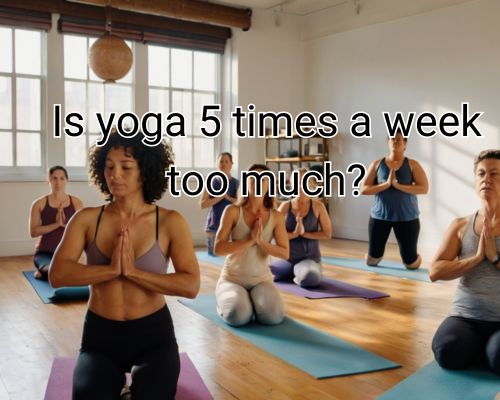In the health-conscious community of Mornington, Australia, yoga studios are thriving as more residents seek holistic wellness routines. One of the most frequently asked questions among both newcomers and seasoned practitioners is, “Is yoga 5 times a week too much?” The answer isn’t one-size-fits-all—but it’s rooted in understanding your body’s needs, yoga style, recovery time, and long-term goals.

With Jane Benson of Bikram Yoga Mornington, we’ll unpack the nuances of practicing yoga five times per week, highlight local perspectives from the Mornington Peninsula, and explore how you can tailor your practice without risking burnout or injury.
🌿 Understanding Yoga Frequency: Is Five Sessions a Week Overdoing It?
At its core, yoga is a practice of mind-body harmony. Unlike high-impact exercise like CrossFit or HIIT, yoga—especially when balanced with gentler forms like Hatha, Yin, or Restorative yoga—can be practiced frequently without overtraining.
However, that doesn’t mean daily yoga is automatically ideal for everyone. According to physiotherapists and yoga instructors in Mornington VIC, the question isn’t whether five days a week is too much, but whether the intensity, diversity, and recovery between sessions are appropriate for your physical condition and lifestyle.
🧘♀️ Factors That Determine the Right Yoga Frequency
Let’s break down the key variables that influence whether yoga 5 times a week is sustainable or excessive:
1. Your Yoga Style
- Hot yoga or Bikram yoga (commonly practiced in Mornington studios like Bikram Yoga Mornington) is intense and demanding. Five sessions a week of this kind may lead to fatigue or overuse injuries if not balanced properly.
- In contrast, Yin yoga, Vinyasa flow, or gentle Hatha yoga may support more frequent practice with less strain.
2. Your Experience Level
- Beginners often benefit from 2–3 sessions a week while learning alignment, breathwork (pranayama), and body awareness.
- Advanced yogis or instructors often safely practice 5–6 days a week, but they incorporate varied intensities, functional mobility, and restorative practices to maintain balance.
3. Your Lifestyle and Recovery
If you’re leading a high-stress life—perhaps commuting from Mornington to Melbourne or managing a busy family—your recovery time is crucial. Adequate sleep, hydration, and rest days help your body adapt to frequent sessions.
🌞 Yoga Culture and Wellness in Mornington, Victoria
The seaside suburb of Mornington is known not only for its vibrant coastal charm but also for a flourishing wellness community. Local yoga hubs such as:
- Warrior One Yoga
- Light Space Yoga Mornington
- Bikram Yoga Peninsula
…cater to all levels of practitioners. These studios provide a diverse schedule of classes, including heated yoga, slow flow, Vinyasa, and meditation, allowing practitioners to mix intensities throughout the week.
For many locals, yoga is a lifestyle, not just an exercise. Practicing five times a week isn’t seen as excessive—it’s a rhythm of self-care, stress relief, and community connection.
🔄 The Science of Recovery: Why It Matters
Even if yoga feels gentle, it still challenges muscles, fascia, and joints—especially if you’re doing power yoga, Bikram, or engaging in long holds in Yin yoga. Repetitive strain, like from excessive chaturangas (yoga push-ups), can lead to shoulder injuries or wrist inflammation.
Experts from local clinics like Mornington Peninsula Myotherapy advise that recovery is just as essential as the practice itself. They recommend:
- At least one rest day per week.
- Alternating intense classes with restorative ones.
- Incorporating massage, sauna, or ocean swims for muscle recovery (easy to do in coastal towns like Mornington!).
🔍 Signs You Might Be Doing Too Much Yoga
Practicing yoga five times a week becomes “too much” when it causes more harm than good. Look out for these red flags:
- Chronic fatigue or burnout
- Loss of motivation or emotional irritability
- Persistent muscle soreness or injuries
- Sleep disturbances
- Plateau in flexibility or strength progress
If these show up, it’s a good idea to scale back, diversify your movement (e.g., swimming at Mornington Main Beach or walking the Balcombe Estuary Boardwalk), or consult a local allied health professional.
🌺 Mental and Emotional Benefits: Why More Yoga Might Be Just Right
While overtraining is a concern for physical recovery, many people practice yoga five times a week not for the workout, but for the mental health benefits.
Mornington’s tranquil coastal environment makes it ideal for yogic mindfulness, which supports:
- Reduced anxiety and stress
- Improved emotional regulation
- Better sleep and mood
- Enhanced focus and clarity
Local mental health practitioners frequently recommend yoga as part of holistic therapy. Practicing five times a week can be therapeutically supportive, especially if your sessions include breathwork, meditation, or sound healing, which are increasingly common offerings in Mornington yoga studios.
✅ Yoga 5x Per Week: Tips to Do It Safely
If you decide to commit to a five-day yoga routine, here’s how to make it safe, sustainable, and soul-nourishing:
- Vary the Style
- Alternate between power, flow, and restorative sessions.
- Listen to Your Body
- Modify or skip poses when tired or injured.
- Prioritize Hydration and Nutrition
- Especially important for heated classes like Bikram or Hot Flow.
- Include Recovery Days
- Consider a gentle walk on the Mornington Peninsula coastal trail or a beach day instead.
- Work with Certified Instructors
- Local studios offer trained teachers who can tailor sessions to your body’s needs.
🔚 Conclusion: Yoga Frequency is Personal—Mornington Style
So, is yoga 5 times a week too much? Not inherently.
In the context of Mornington’s wellness-centric lifestyle, five yoga sessions weekly is a realistic and even optimal rhythm—if done mindfully. It can improve flexibility, balance hormones, reduce stress, and even cultivate deeper community engagement.
The key is to match your intensity with recovery, mix styles, and stay attuned to your body. When yoga becomes a form of rejuvenation rather than obligation, five days a week becomes not only sustainable but transformative.




